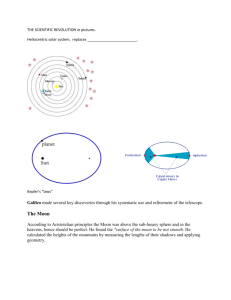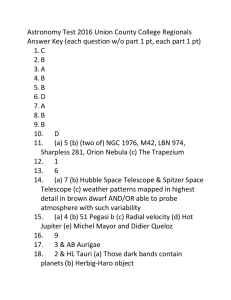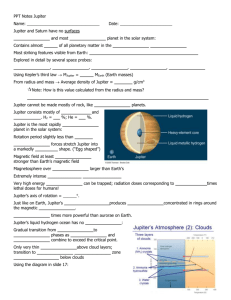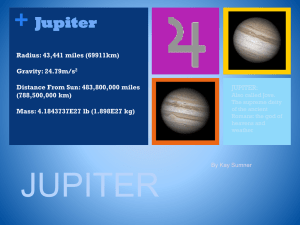Jupiter: King of the Gods - Maverick's E
advertisement
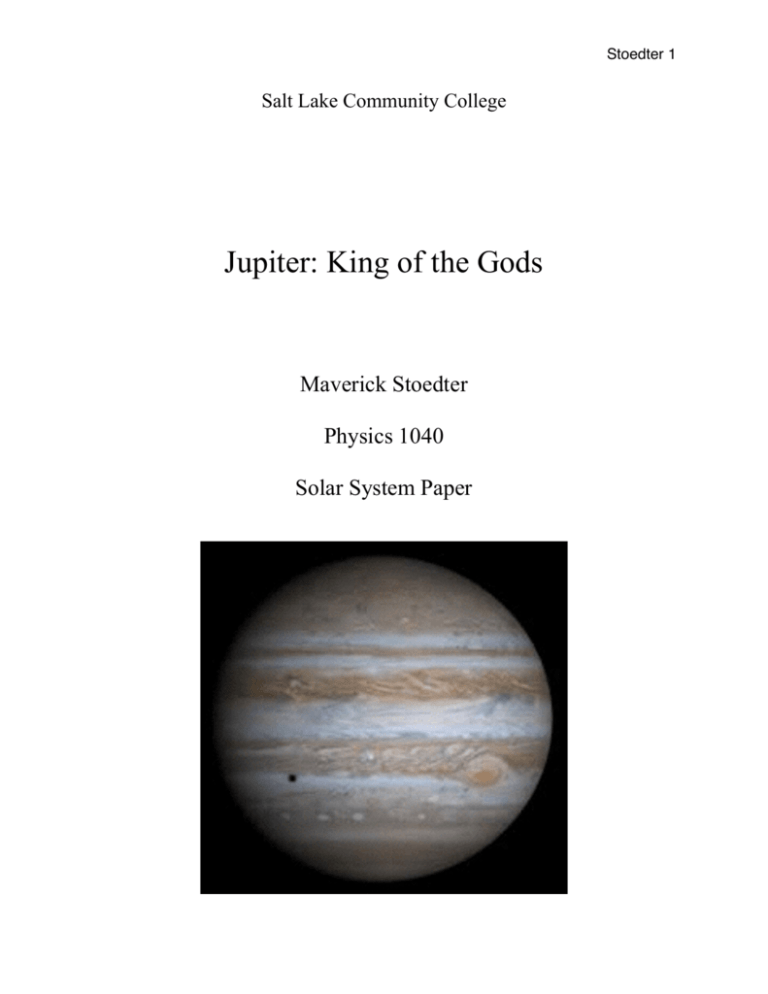
Stoedter 1 Salt Lake Community College " " " Jupiter: King of the Gods " Maverick Stoedter Physics 1040 Solar System Paper Stoedter 2 Jupiter; 5th planet from the sun, one of the largest of it’s kind, and home of the Great Red Spot, and King of the Gods(Rome, Pars. 2). People have been fascinated by Jupiter for thousands of years. The Romans referred to Jupiter as the King of the Gods, due to the brightness and size of the planet. Jupiter, the Roman God demanded respect and so does this planet. However, there is more to this planet than just brightness and size. For example, Jupiter’s Great Red Spot is a storm that’s been raging for more than 350 years. A storm so big that you could fit two earths inside. Jupiter is also home to sixty-three moons, more than any other planet in the solar system (nineplanets, pars. 25). Jupiter is immense, covered in thick clouds of hydrogen and helium. Jupiter is a cruel planet, with violent storms frequently pestering the gas giant. There’s much more than what meets the eye with Jupiter, which we will begin to delve into. Jupiter is the largest planet in the solar system. In fact, it is so large that if Jupiter were hollow you would be able to fit over 1,300 Earths inside (Simon 3). It’s hard to imagine Jupiter’s immensity. As an example, If you were to combine all the other planets Jupiter would still be one-and-one-half times the mass(Simon 3). Jupiter is about as large as it can get, if more material were to be added gravity would then compress the gas planet making it smaller in size(nineplanets, pars. 18). Jupiter acts like a bodyguard to earth. It’s gravitational pull is so large most of the asteroids or comets that travel towards the Earth end up getting sucked into Jupiter. As big as Jupiter is it would still need to be around eighty times larger in order to be considered a star. Now that we know that Jupiter is massive let’s take a deeper look on what Jupiter is made out of. Jupiter’s composition consists of about 90 percent hydrogen and 10 percent helium. It’s composition is very similar to that of Saturn. There is evidence that Jupiter a core made out of Stoedter 3 rocky material that is about 15 times larger than Earth(nineplanets pars. 5-7). Above the core is mostly liquid metallic hydrogen which makes up most of the planet. Jupiter has three layers that consist of traces of ammonia ice, ammonia hydrosulfide. Due to Jupiter’s core being about 20,000 K. Jupiter has a convection system. Warm gas rises and later sink as the gasses get further away from the core and then cool down. On Jupiter the lighter bands are called “zones’ while the darker bands are called “belts” the difference in color is due to their chemical compositions (coolcosmos pars. 3). The lighter bands are the gasses that are rising. While the darker bands are sinking. Jupiter isn’t able to produce heat from nuclear fusion because it is just too small. Making Jupiter reliant on its hot core to produce heat. Jupiter is home to the famous Great Red Spot. It’s a storm that has been raging for at least 350 years. It’s the largest storm in the solar system. Winds can reach speeds up to several hundreds of thousands of miles per hour(Discovery, pars. 3). It was founded by Robert Hooke in 1664 and has been raging ever since Nasa, release 14-135 (enchantedlearning, pars. 3). It’s a massive hurricane that has lasted so long because it never touches the ground. Evidence now shoes that the Great Red Spot is finally starting to grow smaller. There are several other storms on Jupiter but none Stoedter 4 have lasted as long as the Great Red Spot that we have been able to observe. Here are some measurements of the planet Jupiter. Table provided by (uoregon, page 11) As the table shows Jupiter has 63 moons with 16 major moons. The first moons were discovered by Galileo on January 7th 1610. Galileo used a homemade telescope and was able to see three moons orbiting Jupiter. It took Galileo a few weeks to observe the fourth moon(nasa pars. 2). We named these Galilean moons after Galileo. The four Galilean moons are Callisto, Io, Europa and Ganymede. Stoedter 5 Table provided by (uky, table #2) Let’s take a deeper look into each of these moons because they are all very different and exhibit very interesting characteristics. Let’s start with Io, the moon was named after the princess of Argos tracing back to greek mythology. Io is slightly larger than our own moon. It’s the most volcanically active body in the entire solar system. It’s entire surface is covered in massive volcanoes, nearly half of the material it spits out is able to reach escape velocity from the moon (nasa, pars. 1). It’s surface is mostly liquid due to how hot it is, the surface is constantly getting renewed because of the molten lava constantly flowing (Nasa, pars. 4). Next is the biggest moon in the solar system. Ganymede, Greek meaning is the cup bearer to the gods. It’s very different from Io, instead of being covered in lava Ganymede is mostly ice. Ganymede is heavily cratered which means that it is unable to renew its surface which means it is not geologically active. Ganymede does have a very thin atmosphere with oxygen but is far too little to support any life(Nasa, pars. 3). Callisto which means nymph of Lycaon in Greek mythology. It’s the third largest moon in the solar system. Callisto is surrounded by a large icy mantle. It’s the most heavily cratered object in our solar system. The planet is considered to be long dead and hasn’t been geologically active for a very long time. The last of the Galilean moons is Europa. Evidence points that Europa could have a global ocean underneath the surface. If confirmed this could be a promising place to try and find life(Nasa, pars. 1). There have been multiple missions sent to Jupiter and it’s satellites. In 1972 the first mission to go to Jupiter was the Pioneer 10. It flew by and was able to collect data on the magnetic field of jupiter. Along with several measurements on the Jupiter’s atmosphere. The next year in 1973 they sent the Pioneer 11. That mission was also successful and they were able to Stoedter 6 measure Jupiter’s magnetosphere. Pioneer 11 was also able to get a first glimpse at Jupiter’s polar regions. Both of these spacecraft carry a plague that give a message to any alien life that might stumble across it(nasa. pars.1-2). In 1977 Voyager 1 and 2 both launched and were able to give us a much better idea of Jupiter’s satellites. For example, Voyager1 was able to find that Io was volcanically active(Nasa, pars. 1-4). In 1989 Galileo was launched to the planet to gain information on Jupiter and it’s satellites magnetosphere. Galileo dropped a probe that lasted almost an hour and was later vaporized due to the pressure in the planets atmosphere. A year later Ulysses was sent and was able to solar orbit the planet. It studies the effects Jupiter has on the other planets (Nasa, pars. 2). Cassini was launched in 1997 and helped to further investigate Jupiter’s magnetosphere. Also was able to observe and gather date on Jupiter’s radiation belts. Illuminations, figure [1] The last mission was New Horizons which launched in 2006. It was able to discover lightning near Jupiter’s poles and learned more about the composition of Jupiter’s rings. In total there have been eight missions to Jupiter. All have been successful and we were able to learn something new about the planet that left scientists with more questions than answers. Something that has fascinated me since I watched a documentary several years ago is the satellite Europa. I hope they send a spacecraft that lands on Europa’s surface and drill down to the underwater ocean and see what is there. A mission like that must take several years of planning and research, I hope they get started on it soon because I want to know. Also, I am very Stoedter 7 intrigued by Jupiter’s massive storms and how they are able to last so long. Researchers should try and study more of the core of the planet and see why it is able to radiate the amount of heat that it does. Science never ceases to amaze me and I’m looking forward to the future missions that we have in store for Mars and for Jupiter. " " " " " " " " " " " " " " " " " " Stoedter 8 Works Cited Seymour, Simon. Destination: Jupiter. New York, HarperCollins, 1988. print. NA, “Jupiter” nineplants.org, NA.web. 8 Oct. 2014. http://nineplanets.org/jupiter.html NA, “Jupiter and Saturn.” coolcosmos. IPAC, 13 Aug. 2013. Web. 6 Oct. 2014. http://coolcosmos.ipac.caltech.edu/page/jupiter_saturn NA “Atmosphere of Jupiter” Wikipedia: The Free Encyclopedia. Wikimedia Foundation, Inc. 15 Sept. 2014. Web. 10 Oct. 2014. " NA “Jupiter: Giant of the Solar System.” Uoregon, Oregon University. 26. Apr. 2011. Web. 7 Oct. 2014 Baalke, Ron. “Discovery of the Galilean Satellites.” Nasa. 24 Jan. 2011. Web. 8 Oct. 2014. " NA “Missions to Jupiter” Nasa. NA. Web. 10 Oct. 2014 https://solarsystem.nasa.gov/missions/profile.cfm?Sort=Target&Target=Jupiter&MCode=PKB " Northon, Karen. “NASA’s Hubble Shows Jupiter’s Great Red Spot is Smaller than Ever Measured.” Nasa. 15 May 2014. Web. 11 Oct.2014 " Zimmerman, Kim. “Callisto Facts About Jupiter’s Dead Moon.” Space. 5 July. 2012. Web. 9 Oct 2014 NA “Missions to Jupiter.” Nasa. NA. Web. 8 Oct. 2014 https://solarsystem.nasa.gov/missions/ profile.cfm?Sort=Target&Target=Jupiter&MCode=Pioneer_11 "


